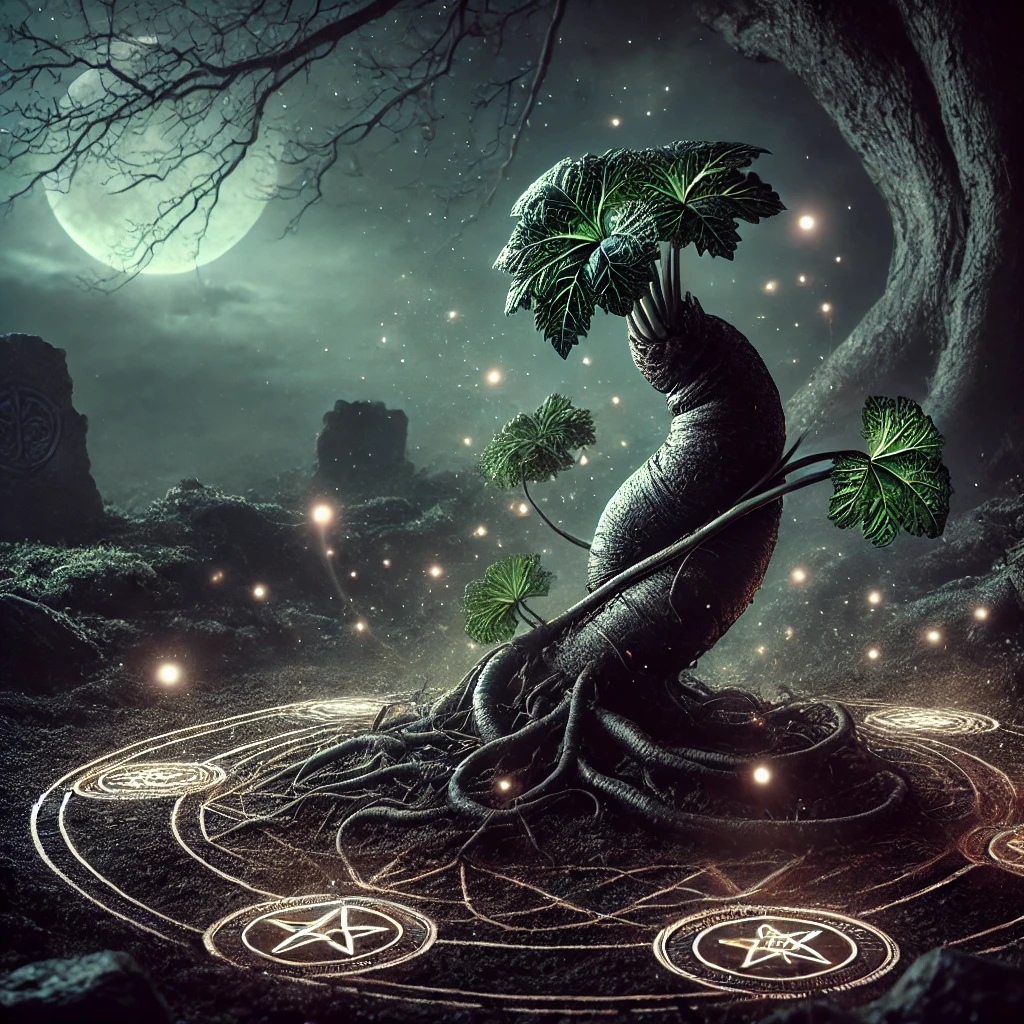Your cart is currently empty!

The European Mandrake: History, Lore, and Magic
The European mandrake (Mandragora officinarum) is one of the most iconic plants in the annals of history, folklore, and magic. Its roots, which often resemble the human form, have inspired awe, fear, and fascination for centuries. Often entwined with myths of potent magical properties, the mandrake has been a cornerstone of European occult practices and literature. This essay explores the history, cultural significance, and practical applications of the European mandrake, focusing particularly on its use in magical rites, spells, and ceremonies. With historical references and detailed recipes, this exploration reveals the mystique of a plant that has captivated humanity’s imagination.
Chapter 1: Historical and Cultural Context
The European mandrake has been recognized since antiquity. Its earliest mentions date back to ancient civilizations, where it was revered for its medicinal and magical properties.
1.1 Ancient Origins The mandrake’s use can be traced to ancient Mesopotamia, where it was associated with fertility and aphrodisiac qualities. The plant was considered sacred, with its roots used in both healing rituals and spiritual ceremonies. Ancient Egyptians referred to it as the “love apple,” and depictions of mandrake plants have been discovered in tomb art and temple inscriptions. These artifacts suggest that the Egyptians believed the mandrake had the power to bridge the mortal and divine realms, ensuring prosperity in both life and death.
In ancient Greece, the mandrake was described by physicians like Hippocrates and Theophrastus. Hippocrates highlighted its use as a sedative and a remedy for various ailments, while Theophrastus noted its peculiar shape and mystical connotations. Dioscorides, in his seminal work De Materia Medica, classified mandrake as an anesthetic and aphrodisiac, detailing its medical and mystical applications. Mandrake root was said to induce visions and was used in rituals to commune with the divine. Its intoxicating effects were carefully managed to avoid harm, as improper use could lead to madness or death.
1.2 Biblical and Religious Significance Mandrakes appear in the Bible in Genesis 30:14-16, where Rachel trades a night with Jacob for mandrakes harvested by Leah. This passage underscores the plant’s association with fertility and desire, themes that persist in its folklore. The biblical narrative highlights the belief that mandrakes possessed the power to influence conception and love, making them highly sought after in ancient Hebrew culture.
In medieval Christianity, the mandrake’s anthropomorphic root was linked to Adam and Eve—sometimes believed to have sprouted from their tears or blood. This connection to human origin further cemented its mystical reputation. Church authorities alternated between condemning the plant as a tool of witchcraft and acknowledging its use in religious healing practices. Monastic herbalists documented the plant’s properties in manuscripts, often blending pagan traditions with Christian symbolism.
1.3 Folklore and Superstition In European folklore, the mandrake was shrouded in superstition. It was widely believed that the mandrake grew beneath gallows, nourished by the bodily fluids of hanged men. This macabre origin story imbued the mandrake with associations of death, rebirth, and justice. The plant’s resemblance to the human form further fueled beliefs that it contained a spirit or soul. Stories circulated of mandrakes screaming when uprooted, their cries capable of killing anyone who heard them. To safely harvest the root, elaborate rituals were devised. One common method involved tying a dog to the plant and ensuring its uprooting from a safe distance, as the animal would absorb the fatal effects of the scream.
1.4 Renaissance and Beyond During the Renaissance, the mandrake gained prominence as a staple in witchcraft and alchemical practices. It was said that witches used mandrake to concoct flying ointments and potions that transformed their appearance. Renaissance occultists, such as Paracelsus, praised the mandrake for its “astral” properties, claiming that it connected the physical and spiritual worlds. Herbalists like Nicholas Culpeper highlighted both its medical and esoteric applications, emphasizing its use as a sedative and a mystical tool.
The mandrake also found a place in the burgeoning field of natural philosophy. Scholars and apothecaries debated its properties, balancing scientific inquiry with centuries-old lore. Despite advances in botanical understanding, the mandrake remained a potent symbol of the unknown, embodying humanity’s fascination with the mysterious forces of nature.
Chapter 2: The Mandrake in Literature and Folklore
The mandrake’s allure extends deeply into literature and folklore, where it is often portrayed as a plant of perilous power.
2.1 Classical Literature William Shakespeare references the mandrake’s deadly scream in Romeo and Juliet (“And shrieks like mandrakes torn out of the earth…”). This belief, that uprooting the mandrake resulted in a fatal shriek, added an element of fear to its mystical reputation. Such tales likely originated from ancient traditions where elaborate rituals were devised to harvest the root without harm. Similarly, John Donne alluded to the mandrake’s sinister properties in his poem “Song” (“Go and catch a falling star… and find / What wind serves to advance an honest mind”), using the plant as a symbol of impossibility and danger.
Beyond these references, classical works often depicted the mandrake as a tool wielded by witches, magicians, and alchemists. In mythological contexts, it was associated with the underworld and transformative powers, aligning it with themes of death and resurrection.
2.2 Medieval Bestiaries and Folktales In medieval European folklore, the mandrake was personified as a plant with a soul. It was believed to grow beneath gallows, nourished by the bodily fluids of hanged men. This macabre origin story imbued the mandrake with associations of death, rebirth, and justice. Its roots, resembling the human form, further fueled beliefs that it was imbued with life.
One prevalent folktale involved the mandrake being gifted to individuals by the devil himself, cementing its reputation as a plant of dark power. Monks and scribes who documented these stories in bestiaries often presented the plant as both a cautionary symbol and an object of awe. In many tales, the mandrake was a pivotal element in quests for forbidden knowledge, representing the dual nature of temptation and enlightenment.
2.3 Fairy Tales and Local Legends Fairy tales across Europe often wove the mandrake into their narratives. In Germanic folklore, the “Alraune,” a humanoid mandrake figure, was said to bring wealth and prosperity to its owner but at a terrible moral cost. Legends warned that owning an Alraune could lead to untold misery if its owner failed to treat it with care. In Slavic traditions, mandrake roots were considered talismans capable of warding off evil spirits and ensuring safe passage in the afterlife. The plant’s magical properties were often compared to those of dragons or other mythical beings.
2.4 Modern Literary Depictions The mandrake continues to appear in modern literature, symbolizing mystery and the occult. In J.K. Rowling’s Harry Potter series, mandrakes are reimagined as plants whose screams are lethal to those who hear them. This depiction echoes medieval lore while adapting it for a fantastical context. Similarly, in fantasy novels by authors such as Neil Gaiman and Terry Pratchett, mandrakes are often used as symbols of ancient magic, bridging the gap between the mundane and the supernatural.
Chapter 3: Magical Uses and Recipes
The mandrake’s magical applications are myriad, spanning love spells, protection charms, and divination rites. Its reputation as a potent magical catalyst has led to an extensive repertoire of recipes and rituals.
3.1 Harvesting the Mandrake Traditionally, harvesting the mandrake was considered dangerous due to the belief in its fatal scream. Ancient methods included tying a dog to the plant and ensuring its uprooting from a safe distance. A common medieval instruction involved plugging one’s ears with wax and offering prayers or chants to appease the plant’s spirit. Additionally, rituals often included drawing a protective circle around the plant to ward off any spirits that might be angered during the process.
3.2 Love and Fertility Spells The mandrake has long been used to attract love and ensure fertility. One common medieval recipe for a love potion included:
- Ingredients:
- A small piece of dried mandrake root
- Honey
- Rose petals
- A pinch of cinnamon
- Instructions:
- Grind the mandrake root into a fine powder.
- Mix with honey, rose petals, and cinnamon to form a paste.
Consume a small amount while reciting an incantation invoking Venus. The invocation to Venus could vary, but one example from Renaissance texts suggests the following words:
“Oh Venus, goddess of love divine,
Bless this heart and make it thine.
Through mandrake’s power, love’s flame ignite,
Bring to me my heart’s delight.”
This spell was often accompanied by the lighting of red candles and the scattering of rose petals to enhance its potency.
For fertility, the mandrake root was steeped in warm milk, which was then consumed by both partners seeking to conceive. In some regions, women would sleep with a piece of mandrake root beneath their pillows, believing it would bestow fertility through dreams of guidance from the plant’s spirit.
3.3 Protection Charms and Amulets
Mandrake roots were often fashioned into protective amulets, believed to ward off evil spirits and bring good fortune. A popular method involved:
- Ingredients:
- A dried mandrake root
- Black thread
- Red silk fabric
- A few grains of salt
- Instructions:
- Wrap the dried root in the silk fabric and secure it with black thread.
- Sprinkle salt over the bundle, invoking protective deities or ancestors for blessings.
- Carry the charm on your person, particularly during travel or times of potential danger.
Households also placed mandrake talismans at doorways or windowsills to prevent malevolent forces from entering. In some traditions, burying a mandrake beneath the threshold was believed to create a permanent protective barrier.
3.4 Divination and Spirit Communication
The mandrake’s psychoactive properties made it a key ingredient in rituals for scrying and necromancy. To enhance psychic visions, practitioners often created mandrake incense.
- Ingredients:
- Dried mandrake root
- Frankincense resin
- Myrrh
- Sandalwood powder
- Instructions:
- Grind all ingredients into a fine powder.
- Burn the mixture on charcoal in a quiet, dimly lit room.
- Gaze into a mirror or crystal ball while inhaling the incense, focusing on the desired vision or spirit communication.
Some texts describe using mandrake oil\u2014made by infusing mandrake root in olive oil for a lunar cycle\u2014to anoint the third eye before divination.
3.5 Flying Ointments and Trance Induction
Witches famously used mandrake in flying ointments to achieve altered states of consciousness or astral projection. A historical recipe from the 16th century includes:
- Ingredients:
- Mandrake root
- Belladonna
- Henbane
- Datura
- Animal fat (traditionally goose or pork fat)
- Instructions:
- Render the fat and add finely ground herbs, including mandrake root.
- Simmer over low heat, stirring with an enchanted wand or wooden spoon.
- Strain and store the ointment in a dark jar.
The ointment was applied sparingly to the wrists, temples, or soles of the feet to induce trance states. Careful measurement was crucial, as an overdose could lead to severe poisoning. Accounts from witch trials often exaggerated these practices, adding to the aura of danger surrounding mandrake use.
3.6 Healing Rituals and Anointing
While mandrake was infamous for its magical and mystical uses, it also played a role in healing rites. It was used to treat insomnia, anxiety, and pain relief, often through anointing oils or teas. A common preparation included:
- Ingredients:
- A piece of mandrake root (dried and powdered)
- Chamomile flowers
- Lavender buds
- Honey
- Instructions:
- Steep mandrake root with chamomile and lavender in boiling water for 10 minutes.
- Strain and sweeten with honey.
- Drink before bedtime to induce restful sleep or ease nervous tension.
Additionally, mandrake poultices were applied to wounds or inflamed areas to reduce pain. Ritual chants were often recited during application to invoke the plant’s healing spirit.
3.7 Banishing and Exorcisms
Mandrake was used in banishing spells to dispel curses, hexes, or negative entities. A common banishing ritual involved burning mandrake incense while chanting:
“By root and flame, I cast thee out,
No ill shall linger, no shadow of doubt.
Mandrake’s strength, so firm and true,
Cleanse this space, renew, renew.”
The ashes from the burned mandrake root were scattered at the edges of the home or sacred space to seal the area against further harm.
Conclusion
The European mandrake (Mandragora officinarum) has captivated humanity for millennia, occupying a unique space at the crossroads of history, folklore, and magic. From its ancient use in fertility rites and religious ceremonies to its enduring presence in literature and occult practices, the mandrake embodies the mystical relationship between humans and the natural world. Its anthropomorphic roots, potent psychoactive properties, and associations with life, death, and transformation have inspired awe, fear, and reverence across cultures and centuries.
As a symbol of the mysterious and the otherworldly, the mandrake has bridged the gap between myth and reality. It has served as a tool for healing, a source of protection, a medium for divination, and a vessel for love and desire. Whether invoked in ancient rituals or reimagined in modern literature, the mandrake continues to represent the enduring human quest for knowledge, power, and connection with forces beyond our comprehension.
Though its magical uses are steeped in lore and legend, the mandrake also reminds us of the need for respect and caution when engaging with the natural world. Its dual nature—as a plant of healing and harm, of beauty and danger—makes it a powerful symbol of balance and the mysteries that lie at the heart of life itself. Through its rich history and cultural significance, the mandrake remains a timeless testament to the ways in which nature can inspire, challenge, and transform the human experience.






